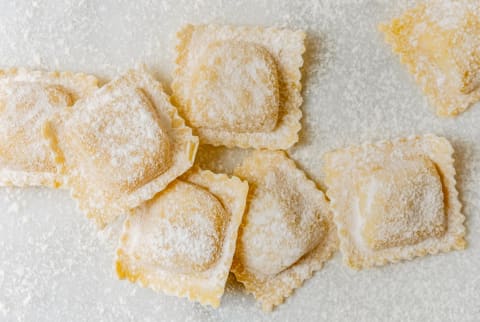Advertisement
This Homemade Pasta Has A Fermented Secret Ingredient


Let's quickly make one thing clear: Pasta can totally be part of a healthy diet, whether you're opting for a modern healthier pasta or a longtime classic favorite. But making your own pasta is actually...pretty easy. It takes a bit of patience and elbow grease but only a few ingredients—and the final product will probably taste even better than your most favorite prepacked product.
Not only that, but it's an opportunity to add unique flavors that complement your favorite sauce to your pasta dough itself—but there's another ingredient you could be adding that gives the added benefits of making pasta a bit more palatable to your gut: sourdough starter.
This recipe, from the upcoming cookbook Sourdough Every Day by Hannah Dela Cruz, harnesses your quarantine hobby as a key component in the five-ingredient mix: "Equal proportions of semolina flour and all-purpose flour result in a tender pasta with a tasty little tang that's easier to digest than other fresh pastas because of the sourdough discard," she explains.
As with any fermented product, the longer you let it hang, the more fermentation benefits you'll get—so while you can use the dough after only a couple of hours' rest time, it can be left to ferment for up to a full 24 hours. "Fermented or not, though, the sourdough adds a complexity of flavor that is delicious with any pasta sauce," writes Dela Cruz. We're willing to bet it'd match up well with this easy pesto, in particular.
Semolina Egg Pasta
Serves 4
Ingredients
- 1 cup (120 g) all-purpose flour
- 1 cup (120 g) fine semolina flour
- 1 tsp. kosher salt
- ½ cup (113 g) sourdough discard
- 2 large eggs
Method
- In a large bowl, combine the all-purpose flour, semolina flour, and salt. Make a well in the center and add the sourdough discard and eggs. Using a fork, break up the egg yolks and incorporate the flour, little by little, until a paste forms.
- Turn the dough out onto a work surface and continue adding any unincorporated flour until your mixture forms a ball of dough. It may take a few minutes until all the flour is hydrated and you have a cohesive dough.
- Once your dough forms, knead it for about 10 to 15 minutes, until it appears smooth and elastic with only a few cracks. Kneading your dough will impart structure to your pasta and ensure your noodles will not break apart when cooked.
- Cover the dough with plastic wrap and allow it to rest at room temperature for at least 2 hours. After this initial rest period, you can take advantage of the fermentation benefits of sourdough by placing your wrapped pasta dough in the refrigerator and allowing it to ferment for up to two days. Or you can cut the dough right after its 2-hour rest.
- When you're ready to cut your pasta, sprinkle a generous amount of flour on a large baking sheet and set it aside.
- Use a sharp knife to cut your dough into four equal portions. Place one wedge on a floured work surface and immediately wrap the remaining three in plastic wrap to prevent them from drying out. Using a rolling pin, roll the dough wedge into a rectangle that is thin enough to go through the widest setting on your pasta machine.
- Liberally flour the dough and feed it through your pasta machine on its widest setting. When the sheet comes out, fold it into thirds. Repeat once or twice more. Then continue to feed the dough through the machine as you gradually reduce the settings, one pass at a time, until you get to the third thinnest setting.
- Dust the dough with more flour if it feels sticky as you go; and if your dough gets too long to handle, simply use a knife to cut the dough in half. Set the rolled-out pasta dough on the prepared baking sheet and cover it with plastic wrap to prevent it from drying out. Repeat this process with the rest of the dough portions.
- Attach the cutter attachment to your pasta machine (chose any size noodles you like). Liberally flour one sheet of pasta and carefully feed it through the cutter attachment. Once cut, dust the noodles with flour to prevent them from sticking together. Swirl the noodles into a nest and return them to the floured baking sheet. Repeat until all the pasta sheets have been cut.
- Cook the pasta in a pot of well-salted boiling water for 90 seconds. You can also freeze the uncooked pasta nests uncovered for 30 minutes, and then transfer them to the zip-top bag. They will keep for up to 1 month. You don't need to adjust the cooking time when preparing frozen pasta.